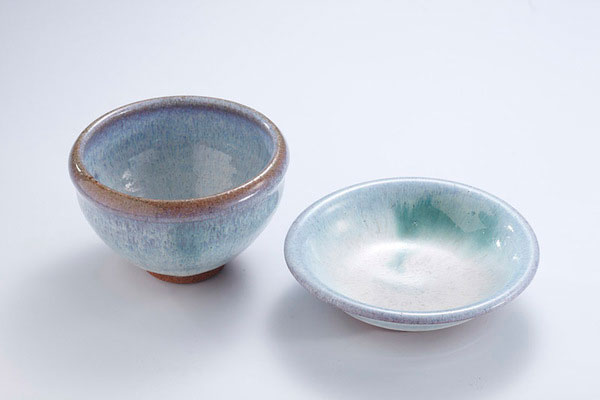
- Ceramic
- Fukushima
Aizu-hongo ware Aizu hongo yaki
Area historically famous for its ceramics
Each atelier has a different style
Description
What is Aizu-hongo ware ?
Aizu-hongo ware (called Aizu-hongo yaki in Japanese) is a traditional handicraft from the region of Aizu in Fukushima prefecture with a history of about four hundred years. This pottery, which is thought to have originated during the Sengoku period (1467-1600), was patronized and promoted by the lord of the Aizu domain (now the region of Aizu) at the beginning of the Edo period (1603-1868). Then various pottery operations launched independent production due to the dissolving of the magistrate’s office and each place produced pieces in its own unique style. Aizu-hongo ware includes both ceramics and porcelain and there are pottery places specializing in either porcelain or ceramics, as well as those producing both.
The differentiating feature of Aizu-hongo ware is its varied types of decoration including blue paint called asbolite, other traditional Japanese paints, and paints from the West.
Many practical use ceramics are produced using traditional enamel. There are many styles, such as celadon* porcelain, white porcelain, and carbonization, as well as different finishes (glossy and non-glossy) and textures.
*Celadon or seihakuji refers to a glaze with mixed subtle color gradations of icy, bluish white.
History
Production of Aizu-hongo ware is said to have originated in 1593 when the military commander, Ujisato GAMO, became lord of the Aizu domain, and roof tile production was commissioned while restructuring what is now the Aizuwakamatsu Castle. Consequently, at the beginning of the Edo period, Masayuki HOSHINA, the head of the Aizu-Matsudaira clan relocated potters from Owari (today the western half of Aichi prefecture) to begin full-scale production. The production of ceramics and porcelain grew with support from the domain. However, the industry would face two difficult periods due to the effects of war. At the time of the Boshin war (civil war, 1868-1869), potters left to fight in battle and porcelain factories were burned down, forcing the industry into a state of inactivity. Afterwards, all of the villages united their production activities and the craft recovered to such an extent that by the middle of the Meiji period (1868-1912), its products were being exported to the West. In 1916, most of the porcelain factories were destroyed yet again in a large fire, putting the industry in a dilemma, but once again it recovered well.
Thus Aizu-hongo ware has overcome periods of upheaval to continue its long history without being stamped out. This craft has become widely known as a form of ceramics and porcelain that has simple beauty and ease of use.
Production Process
- 1. Weather exposure
The clay material is exposed to wind and rain for at least a year before the process begins.
- 2. Kneading
The element-exposed clay is broken up and sieved, after which water is added and the clay is kneaded.
- 3. Lathe casting
A lathe is used to cast the desired form. While it is rotating, the clay is spread out and pushed up to the top while the shape is put in order. Then the lathe is stopped so the edges of the clay can be smoothed with leather.
- 4. Drying
Items that have been cast are dried by natural or heated drying. When pictures are painted on them, the designs are applied either directly or after bisque firing which is an initial firing done at a low temperature before any glaze is applied.
- 5. Firing
Pieces are baked inside the kiln for differing periods of time depending on what each one requires.
- 6. Removal of pots from the kiln
In order to prevent breakage, the completed articles are carefully cooled inside the kiln and only removed once they have cooled completely.
- 7. Inspection
The completed products are given a final inspection to confirm that there are no defects.
Facility Information
Fukushima Product Promotion Center
-
Address
-
Tel.+81-24-525-4031
-
Closedopen everyday
-
Business Hours9:30am to 7pm
-
Website
Related Artists
- You will be redirected to the artist's page on the Gallery Japan website
Other Ceramic
- Imari ware/Arita ware
- Hasami ware
- Kutani ware
- Mashiko ware
- Shigaraki ware
- Bizen ware
- Hagi ware
- Koishiwara ware
- Mino ware
- Tobe ware
- Tokoname ware
- Karatsu ware
- Kasama ware
- Satsuma ware
- Iga ware
- Mikawachi ware
- Agano ware
- Otani ware
- Obori-soma ware
- Tsuboya ware
- Aizu-hongo ware
- Shodai ware
- Echizen ware
- Akazu ware
- Tamba-tachikui ware
- Yokkaichi-banko ware
- Izushi ware
- Kyo ware/Kiyomizu ware
- Iwami ware
- Amakusa ceramics
- Seto-sometsuke ware
- Sanshu Onigawara Crafts































































































































































































































































































